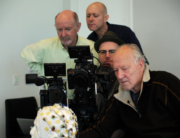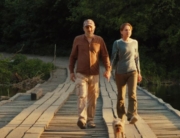
Sam Harkness, age 19, dressed as his alter ego the Blue Panther on Mt. Hood in Oregon, 2005, as seen in Sam Now (Ha/Ha Productions)
Home movies usually highlight the good times: weddings, birthdays, graduations, kids playing, family parties. But the hard stuff—difficult conversations, outpourings of bruised feelings, accusations, and explanations—most families don’t put that on film. Or if they do, they delete it.
Reed Harkness didn’t delete. Growing up in Seattle in the 1990s, he began making films starring his younger half-brother Sam, a daredevil with the kind of open-heartedness and ease on camera that perhaps can only come with a life lived endlessly on film. At first, their productions were just the usual projects of aspiring directors, homemade horror movie and backyard action films. But then, in 2003, Reed asked his brother if he could film Sam as they set out to solve a family mystery. The result is Sam Now, a lovely documentary that tries to unpack how one person’s decision can affect so many in so many ways.
When Sam was in his early teens, his mother, Jois (Reed’s stepmother), disappeared. She was already divorced from Sam’s father, and although the boys lived with their dad, she had lived nearby and stayed closely involved in the lives of Sam and her other son Jared. Then, she suddenly left town, without any explanation of why, where she had gone, or how anyone could contact her. The most the family could find out from the police was that she was okay but didn’t want to be contacted. No one ever really talked about it, and life went on, until 2003 when Reed and Sam set off to find Jois, accompanied by Reed’s ever-present camera.
The beauty of a film like this that follows its subjects for about 25 years—including the earliest movies made by Reed of Sam—is that we witness how the family evolves. The mystery of finding Jois isn’t really the heart of the documentary. The story is more about how the feelings of everyone become clearer as time passes and as they realize how choices affected them. We see the way 17-year-old Sam reacts when he finds his mom, but we also see how his thoughts about that moment change as he reaches his thirties. The feelings he could push away when he was a teen become harder to avoid as he ages.
The most striking aspect about the documentary is its look. The narrative is traced through standard talking-head interviews. But the home movie footage that was filmed on Super 8 cameras in the 1990s are often mesmerizingly beautiful. The video scenes look great too, and yes, we all love video and the convenience it has afforded us, but when you see the actual warmth of film, it’s hard not to think about what we have lost to that convenience.
It’s easy to compare Sam Now to a movie like Boyhood, but, of course, real life is messier and murkier than a scripted film. There are no neat wrap-ups or shocking revelations. I got the feeling sometimes that Reed kept filming because he was hoping to capture a huge moment of family catharsis, the kind you might see in a movie, and maybe something that a movie-obsessed person who films everything might imagine could really happen. But it doesn’t, because these are very, very real people who didn’t grow up in a world where you explode with emotion on a regular basis. Instead, you keep your feelings inside. As Sam and Reed’s grandmother says, “You don’t know what goes on in other people. You have no idea what people are thinking or what their deep thoughts are about things. They’re not going to reveal that to you.” So, it ends on a quieter note, where people go on, trying to do their best. Just like real life.






Leave A Comment